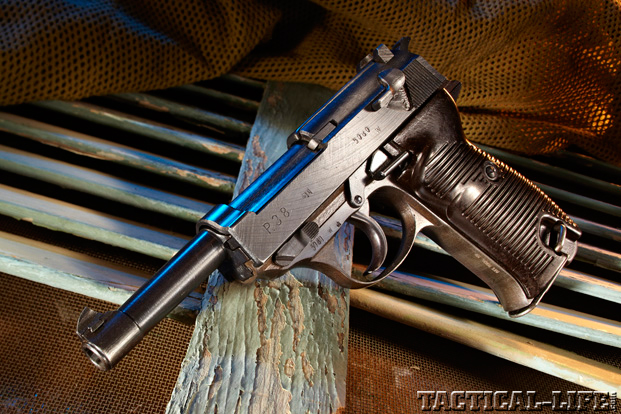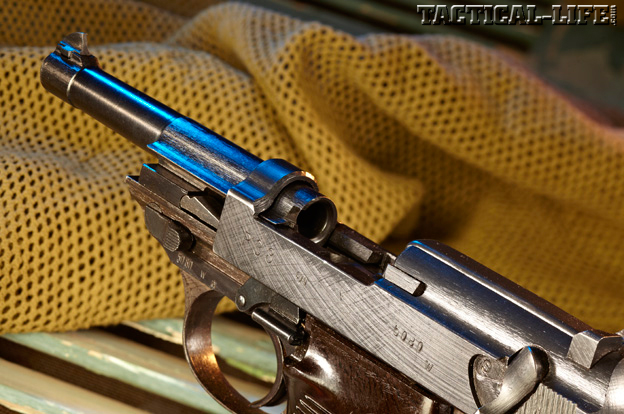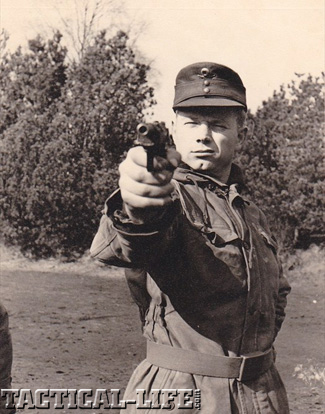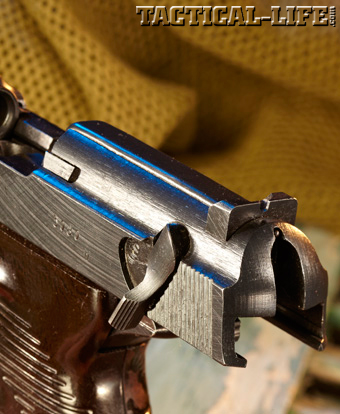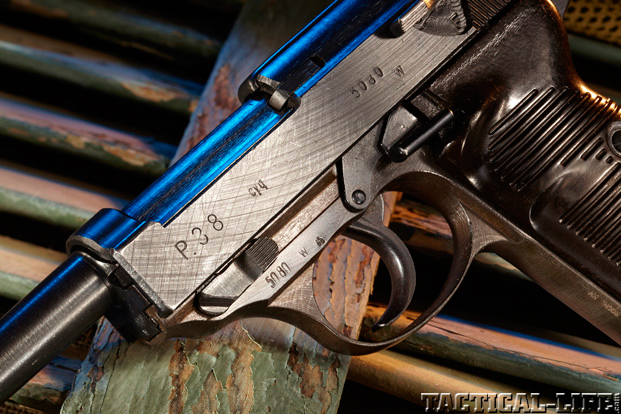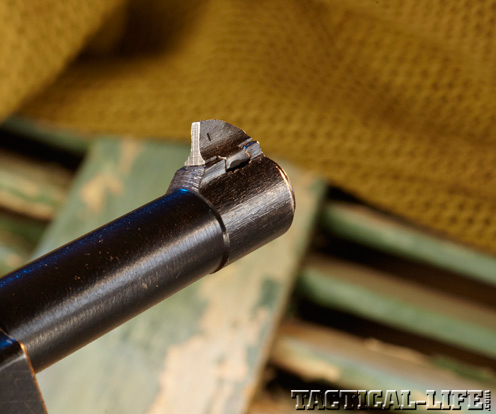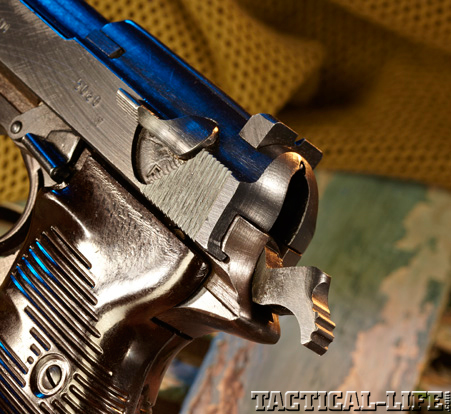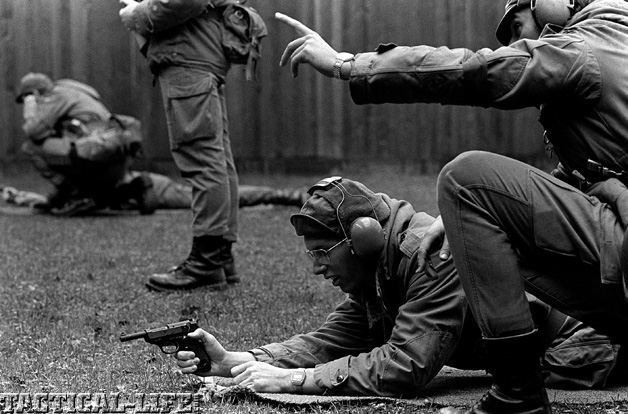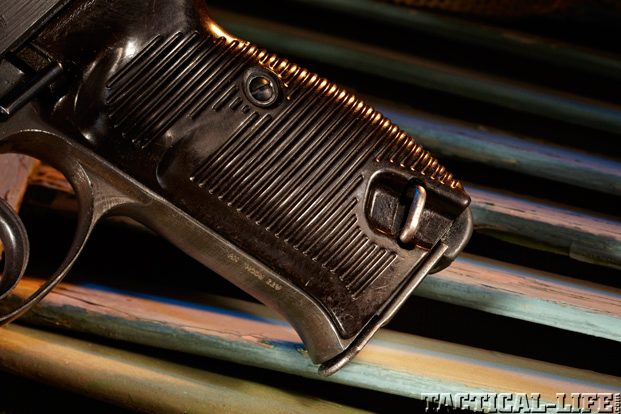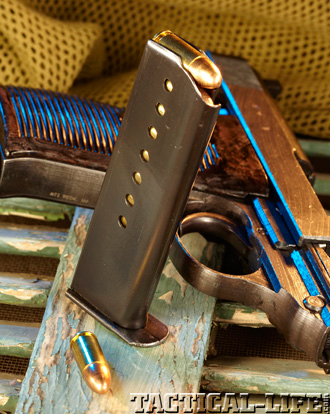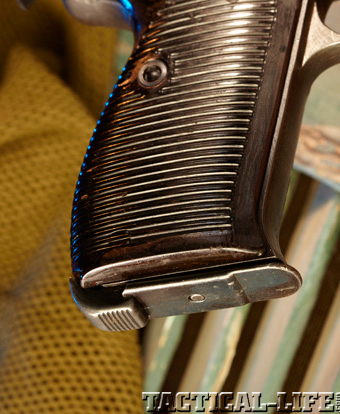Fritz Walther, owner and lead designer for Walther firearms, created a number of semi-automatic pistols known for their elegant lines, compact size, reliable operation and revolutionary design. In the dense woods and rugged hills of Thuringen, at the factory founded by his father, Carl Walther, Fritz created the legendary PP series of pistols. They were the first successful semi-automatics with double-action triggers. Shortly after the emergence of his .32 ACP and .380 ACP PP, the German army advised Walther that it had begun searching for a new standard 9x19mm Luger service pistol to replace its P.08 Parabellum (better known as simply “the Luger”), which had an excellent design but required substantial hand-fitting and machining.
Seeing an opportunity, Fritz Walther quickly developed a series of designs that ultimately lead to the world’s first double-action, semi-automatic military sidearm (and Walther’s first pistol in 9mm Luger), the Walther P.38. On first look, the Walther P.38 is a clear example of a manufacturer understanding its customer: the Walther P.38 had a simple, rugged design that could easily be mass-produced. In fact, well over one million Walther P.38s were made between 1938 and 1945. It was an unqualified success, performing well and remaining in service with the German military and police—and worldwide—for over 50 years.
Old With New
The Walther P.38 is an interesting mix of the old and new or, at least, what was old and new in 1938. It uses a proven short-recoil system of operation. The barrel and slide recoil together over a short distance and remain locked together at the highest pressure point; after the barrel moves rearward about 0.25 inches, the plunger at the barrel assembly’s rear pushes the locking block beneath the barrel assembly and out of its horizontal locking recesses in the forged steel slide. As the locking block falls into a corresponding recess in the frame, it halts the rearward movement of the barrel assembly. The slide, however, continues its rearward travel, guided by rails milled into the forged steel frame. An external claw extractor on the left side of the slide and a pivoting blade ejector pinned to the right side of the frame extract and eject the spent case. A detachable box magazine housed in the grip frame feeds a fresh round into the chamber via a feed ramp milled into the slide. After the slide cocks the Walther P.38’s external hammer, a pair of horizontally opposed recoil springs nested beneath the guide rails drive the slide and barrel assemblies back into battery.
Advertisement — Continue Reading Below
The pivoting locking block is one reason the Walther P.38 is so rugged and reliable. Unlike most recoil-operated, semi-automatic pistols that use a titling barrel that drops out of battery, the Walther P.38’s barrel travel is strictly linear. In addition, its slide is almost skeletonized forward of the breech face, allowing a great deal of space for case travel during ejection.
A stamped-steel sliding magazine release is located on the heel of the frame, at the rear of the magazine well. The magazine is a single-column design that holds eight rounds. Index holes cut in the side of the stamped-steel magazine body show the number of loaded rounds remaining. On the left side of the frame, there is a slide-stop lever at the trigger well’s top-rear. It is partially fenced by an abbreviated thumb shelf molded into the grip panel. The slide stop is also automatically engaged by a rising magazine follower, so the slide automatically locks open after the last round is fired.
A pivoting safety lever is mounted to the slide, just below the rear sight. Sweeping the safety lever downward exposes a white “S” (for “sicher,” German for “safe”) and engages the safety. Pushing upward on the lever reveals a red “F” (for “feuer,” German for “fire”) and, of course, readies the gun to fire. When the hammer is cocked and the safety lever is rotated from the fire position to the safe position, it falls on a locked firing pin—the safety lever also functions as a hammer release, or decocker. Returning the safety lever to the “F” position readies the trigger for double-action firing. At the top of the hammer well is a novel feature for a WWII-era handgun, a loaded cartridge indicator: A pin projects from the top-rear of the slide when there is a round in the chamber; the pin is relatively small and unobtrusive but large enough to be seen or felt in the dark.
Advertisement — Continue Reading Below
Double-Action Design
As mentioned, what separated the Walther P.38 from its contemporaries was its double-action trigger (borrowed from the Walther PP), which enabled safe carry of the pistol with the hammer down on a loaded chamber—there was no need to thumb-cock the hammer or rack the slide to ready the pistol for firing. The action of pulling the trigger cocks the hammer and releases it. In many respects, it is like a double-action revolver, except the action of the Walther P.38’s slide cocks the hammer after each shot, so follow-up shots are fired single-action and require shorter, lighter trigger pulls. Also drawn from the Walther PP is the Walther P.38’s frame, which lacks a backstrap. This saved on raw materials, machining time and, most importantly, weight. The backstrap is formed by a pair of grips that wrapped around the frame in a clamshell fashion, which helps protect the mainspring, trigger bar and other internal components. While Walther’s original design called for walnut grips, the Walther P.38 as adopted by the German army came with Bakelite grips. These grips are either black or brown and come with a series of thin horizontal grooves that have a ribbed appearance. The Walther P.38’s sights are excellent: The rear sight is a broad blade with a deep U-notch, while the front is a tall post—both are drift-adjustable and easy to acquire.
Walther’s original name for its double-action 9mm Luger pistol was the HP (for “heerespistole,” German for “army pistol”). By 1938, Walther HP production was underway and a small number were available for commercial sale—they had been listed in Stoeger’s catalog prior to the U.S.’s entering WWII. When the German army adopted the pistol later that same year, there were very few differences between the commercial HP and the military Walther P.38, perhaps the only significant one being the extractor. The HP had an internal extractor. However, the German army requested an external extractor, believing it would be more reliable. Walther readily complied.
On April 1, 1939, the German army ordered a trial production run of 800 guns. Many of these trial pistols were built from a mix of HP- and Walther P.38-marked components. Some parts even had commercial—rather than military—proofmarks. This was followed by what collectors consider the first true-production Walther P.38s: The “Zero Series.” These guns had serial numbers with a “0” prefix and retained the commercial Walther banner on the slide. Between April 1939 and March 1940, Walther produced just 13,000 Zero Series guns.
Advertisement — Continue Reading Below
Pleased with the performance of these first two runs, in April 1940 the German army awarded Walther a contract for over 400,000 Walther P.38s. Though production ramped up slowly, Walther was able to achieve its goal of 10,000 Walther P.38s per month in April 1941. By the time the Soviets overran the factory in Spring 1945, Walther had built a total of approximately 580,000.
Markings
Note that, after the completion of the Zero Series, Walther was brought in line with the German military’s numeric factory coding system, and the code “480” was stamped into the slide in lieu of the Walther logo. Later that same year, the Germans switched to a code system built around letters—Walther was assigned the “ac” cypher. Frequent changes in marking requirements resulted in many variations among these early guns: some Walther P.38s carried just the “480,” some carried the “480” plus a “40” (for the year of production) and some carried the “480,” the “ac” and the “40” notations. But from late-1940 to war’s end in May 1945, the slides of Walther-made Walther P.38 pistols were rather consistently stamped with both the “ac” code and the last two digits of the year they were produced. The only significant change occurred in the middle of 1943, when Walther switched from what collectors call a “two-line series” with the factory code stamped above the two-digit date, to a single-line arrangement with the letter code and the two-digit date stamped side by side on the same horizontal plane. The single line arrangement of the factory code and the two-digit production year remained Walther’s standard until the end of WWII.
Enter Mauser and Spreewerke
Although Walther proved to be an energetic and efficient manufacturer, it hadn’t the resources to meet the German military’s enormous needs. So, Walther searched for manufacturers capable of efficiently producing the Walther P.38. Mauser was a logical choice, given its long history of producing quality semi-automatic pistols and the fact it was Germany’s largest small-arms manufacturer. In June 1940, the German army ordered Mauser to cease producing the P.08 Luger and begin producing the Walther P.38. Leadership at the Mauser plant was not in favor of this, for reasons of both practicality and pride: On the one hand, it was difficult to switch horses midstream; and on the other, Mauser knew how to make good Lugers and didn’t want to build a gun it didn’t design. The German Army ultimately and reluctantly yielded to practicality, allowing Mauser to continue producing the P.08 Luger until 1942. By the end of that same year, Mauser swallowed its pride and delivered its first 700 Walther P.38 pistols.
Advertisement — Continue Reading Below
In the last 2.5 years of the war, Mauser produced approximately 300,000 Walther P.38s, assigning each one the factory code “byf” and, like Walther, stamping the last two digits of the production year into the slide. To my knowledge, Mauser never strayed from a stacked two-line arrangement of its three-letter code and production date. In the last three months of the war, however, Mauser’s code was switched to “svw.” Mauser-produced Walther P.38s built in 1945 may be marked “byf 45” or “svw 45.” It is likely that the change to “svw” occurred very early in 1945—Walther P.38s marked “byf 45” are rather scarce.
The third and last manufacturer to be tapped was Spreewerke, located in Berlin-Spandau. Spreewerke specialized in producing light and medium artillery pieces, but for reasons that remain a mystery, it was ordered to start producing Walther P.38s. Spreewerke’s Walther P.38s are noticeably rougher in finish than Walther- or Mauser-built pistols. Most have deep, circular cutting marks on the slide, frame and barrel. (Looking at a Spreewerke Walther P.38, it is easy to imagine a heavy milling machine hogging off big strands of steel from its forging.) Spreewerke began tooling up for Walther P.38 production in September 1941 but did not deliver its first test batch of 50 pistols until June 1942, all of which were rejected. But by August 1942, Spreewerke had turned things around: It delivered a larger test run of 300 pistols that made the grade. Ultimately, Spreewerke produced roughly 285,000 Walther P.38s by the end of WWII. Spreewerke Walther P.38s may not the prettiest, but they sure can dance. Spreewerke markings are relatively consistent: All of the frames carry its assigned code “cyq,” but in contrast to Walther and Mauser, Spreewerke never adopted the habit of stamping the production date on the slide—the reason why has never been explained.
Dozens of other makers were assigned to make Walther P.38 parts such as magazines and grips, but they are too numerous to list. One that bears special mention, however, is Fabrique Nationale d’ Armes (FN) of Belgium, which made thousands of Walther P.38 slide assemblies under German occupation. These slides can make things confusing for collectors. They are usually stamped with a two-line manufacturer’s code for Walther, usually an “ac 43” or “ac 44,” despite the fact that they were also supplied to Spreewerke and Mauser. The slides will, however, carry the Waffenamt numbers of the factory that assembled them. That would be “88”for Spreewerke, “359” for Walther and “135” for Mauser.
Advertisement — Continue Reading Below
All told, 1.2 million were made before war’s end, which is certainly an impressive total, but the Walther P.38 was never enough to completely replace the P.08 Luger. Both pistols were designated first-line equipment and served side by side throughout WWII. Postwar, things came full circle: Mauser wound up in the French zone of occupation, and as a result, several thousand Walther P.38s were made for the French military from leftover parts. Most of them have all of the standard late-war Mauser markings, such as the “svw 45” or “svw 46” maker’s code and the eagle “135” proofmark, but with the addition of a five-pointed star on the slide, which represents a French nitro-proof.
Russian Capture
The Red Army captured tens of thousands, perhaps hundreds of thousands, of Walther P.38s during WWII. Naturally, the Soviets gathered them up and put them away for storage. During this process, they were blued, sometimes crudely. (Collectors sometimes refer to them as “dipped guns.”) Unlike K98s, however, the Soviets generally kept the Walther P.38 slides, frames and barrels together, so their major components generally match. Century Arms currently has a number of Mauser- and Spreewerke-produced examples in stock.
They sent me one of their Spreewerke-made examples—I was very impressed. It is an all-matching example stamped “cy8.” It has been re-blued, and the bluing was evenly and attractively applied—I would go so far as to say it showed a measure of skill and care. At the range, the Walther P.38 proved to have a good trigger pull. There was just with a little take-up at the start and a bit of creep just before the break but no stacking. Most importantly, it was very consistent. The single-action pull was stellar and short with a crisp let-off. The sights were well adjusted. My groups were dead on windage-wise, but about 4 inches high at 15 yards. This Walther P.38 was well balanced and had an ergonomically shaped grip, so it was a lot of fun to shoot. Given its 9mm Luger chambering and all-steel construction, recoil was not an issue. These Russian-capture Walther P.38s have been on the market for over a decade, and we are starting to see the bottom of the well. So, if you are interested in buying one, the time is now.
Advertisement — Continue Reading Below
The Walther P.38 is a unique piece of history. It was Walther’s first pistol in 9mm Luger and the first double-action, semi-auto pistol adopted for military service. And while the Walther P.38 lacks the allure of its predecessor, the P.08 Luger, it has a sinister elegance all its own. It is a proven performer, having remained in service with the German military and police for more then 50 years, and an important piece of firearms history. Contact Century international Arms for more information at centuryarms.com; 800-527-1252.
